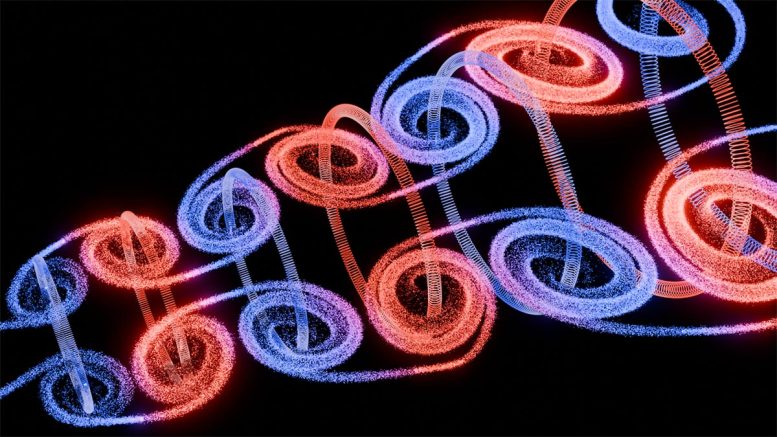Physicists Discover Optical Analog to Kármán Vortex Streets


An artistic impression of a vortex-ring street analog to the structure of magnetic field of a NDSTP, where the right- and left- handed vortex rings were highlighted by blue and red, respectively. Credit: Yijie Shen, Nikitas Papasimakis, and Nikolay I. Zheludev
The Kármán vortex street, an organized pattern of swirling vortices, demonstrates both aesthetic beauty and immense power, ranging from inspiring paintings in Bologne to influencing bridge designs such as the Tacoma Narrow Bridge. Recent studies have explored optical analogs of KVS, revealing potential applications in light-matter interactions and telecommunications.
The Kármán vortex street (KVS) is a highly organized classical flow pattern featuring swirling vortices. It typically includes two sequences of vortices, each emerging from opposite sides of the body, with circulations of opposite signs. This phenomenon is renowned for its aesthetic beauty and tremendous power.
Art Inspiring Science
In the museum at the Church of St Dominic in Bologne, Italy, there is a painting depicting St. Christopher carrying the infant Jesus across a river. The painter has depicted interlaced vortices behind Christopher’s bare feet. Theodore von Kármán stated that his research on vortex streets was inspired by this painting. This represents a fascinating intersection of science and the humanities.
Historical Impact of Vortex Streets
In 1940, a suspension bridge named the Tacoma Narrow Bridge, completed in just four months, suffered damage due to the generation of vortex streets caused by its improper design, leading to vibrations and resonance. This event marked the first time humanity recognized the immense power of the KVS.
Recently, in Nature Communications, collaborating physicists from Singapore and the UK have reported an optical analog of KVS. This optical KVS pulse reveals fascinating parallels between fluid transport and the energy flow of structured light.
Study Insights and Future Applications
“We introduce a type of light pulse whose field structure has an intriguing similarity with a von Kármán vortex street, a pattern of swirling vortices observed in fluid and gas dynamics that is responsible for the “singing” of suspended telephone lines in wind. The structured light exhibits a robust topological structure of skyrmions in condensed matter.
“In sharp contrast to earlier work on optical skyrmionic beams and pulses, the skyrmionic field configuration in NDSTPs is not limited by diffraction and persists upon propagation over arbitrary distances. We anticipate that NDSTPs will inspire potential applications such as light-matter interactions, superresolution microscopy, and metrology,” said Yijie Shen, study lead author, Nanyang Technological University.
Skyrmions, sophisticated topological particles originally proposed as a unified model of the nucleon by Tony Skyrme in 1962, behave like nanoscale magnetic vortices with spectacular textures. To date, all known optical skyrmions in free space do not propagate or only exist around focus and collapse rapidly upon propagation.
Nevertheless, because the light pulses proposed in this paper do not spread during propagation, such skyrmionic field structures can persist upon the KVS pulse propagation. The pulse allows the study of the propagation dynamics of electromagnetic skyrmionic fields and will be of interest as directed energy channels for information transfer applications.
The analogy between KVS in fluid flows and the pulse can be drawn further by considering for instance the motion of electrons along the vortex streets of transverse magnetic pulses or the propagation of the pulses in nonlinear media
Potential Technological Innovations
“We believe the deeply subwavelength singularities of those pulses can be applied in metrology as well as they may interest those studying the spectroscopy of toroidal excitations in matter. Additionally, the pulses could be leveraged for long-distance information transfer encoded in the topological features of the pulses, with potential applications in telecommunications, remote sensing, and LiDAR.” the authors forecast.
Reference: “Nondiffracting supertoroidal pulses and optical “Kármán vortex streets”” by Yijie Shen, Nikitas Papasimakis and Nikolay I. Zheludev, 7 June 2024, Nature Communications.
DOI: 10.1038/s41467-024-48927-5